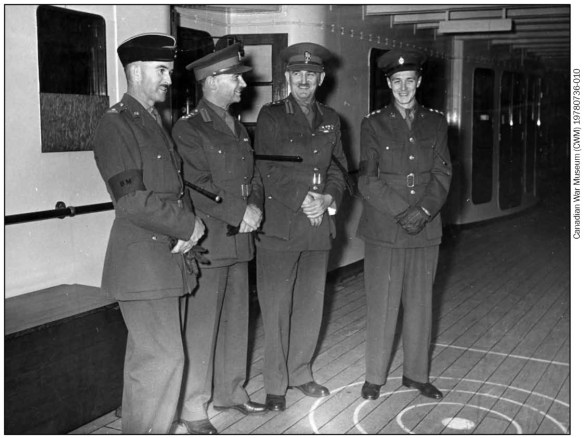Brigadier Lawson with his brigade staff aboard the SS Swansea en route to Hong Kong, October 1941. Left to right: Major C.A. Lyndon, Brigadier Lawson, Colonel P. Hennessey and Captain H.S.A. Bush. Captain Bush was the only one of the four to survive the battle.
At the outbreak of World War II in the Pacific, Hong Kong was a British Crown colony, densely populated over about 400 square miles by 1.4 million persons, virtually all of them Chinese. British military planners understood well that Hong Kong was vulnerable to attack and invasion from the Japanese-occupied Chinese mainland. The 12,000- man British garrison was instructed to hold out as long as possible in the event of an attack, pending the arrival of Chinese forces under Chiang Kaishek (Jiang Jieshi). Inasmuch as Japanese spies had been active in Hong Kong for many years and had provided Japanese military command with highly detailed information concerning the island’s defenses and its troop dispositions, the standing order was little more than wishful thinking. A small garrison could not hold out for any significant length of time against an invasion of any substance.
The British deployed their main defensive line three miles north of Kowloon in the so-called Leased Territories on the Chinese mainland. Three battalions of Scots and Indian troops were deployed much too thinly along the line. Three battalions, including two Canadian battalions, were deployed on the island of Hong Kong itself. A kind of home guard was also present on the island, consisting of poorly equipped locals who manned artillery and antiaircraft defenses. Sea support included nothing more than a destroyer, eight motor torpedo boats (the Royal Navy equivalent of the American PT boat), and four obsolescent gunboats. A mere seven outmoded aircraft constituted the available air forces. All of this small, motley, and inadequate garrison force was under the command of Major General Christopher Maltby.
The attack on Hong Kong came with terrible swiftness on the day after the Battle of Pearl Harbor opened the Pacific theater of World War II. The assault began with an air attack that quickly destroyed, on the ground, all seven British aircraft. This was quickly followed by an overland invasion: The 38th Division of the Twenty-third Japanese Army under Lieutenant General Sano Tadayoshi crossed the Sham Chun River and poured into the Leased Territories. By nightfall, Maltby had been forced to withdraw entirely from the Kowloon mainland and consolidate his position on Hong Kong island.
Sano kept the pressure on Maltby, who completed his withdrawal by December 13. Once this operation had been accomplished, Sano launched relentless air attacks against the business district of Victoria and against the British naval assets in port. Sano ordered his men across to the island on December 15, but, to his chagrin, they were initially repulsed. On December 18, however, Japanese forces landed in strength along a line between North Point and Aldrich Bay. Moving inland, they drove a wedge between the forces of the defenders. The motor torpedo boats that had survived the initial air attacks turned their attention to the Japanese troop transports, but were suppressed by overwhelming Japanese air superiority.
Despite heavy British losses, Sano’s progress was much slower than either he or the Japanese high command had anticipated. Indeed, on December 20, Sano was compelled to halt his general advance to regroup, and it was not until Christmas Eve that the preponderance of Japanese numbers finally prevailed. With supplies and ammunition exhausted, Maltby asked for a ceasefire on Christmas day. That evening, the British governor of Hong Kong formally turned the colony over to Sano’s superior, Lieutenant General Sakai Takashi, commander of the Twenty-third Japanese Army.
British military losses were about 4,400 killed or wounded, among them 800 Canadian dead. The Japanese took much heavier-than-expected casualties: 2,754 killed or wounded. Except for a handful of British and Commonwealth troops who managed to escape, the rest of the garrison became prisoners of war for the duration, and all Western residents of Hong Kong were interned.
Further reading: Greenhous, Brereton. C Force to Hong Kong: A Canadian Catastrophe. Toronto: Dundurn Press, 1997; Roland, Charles G. Long Night’s Journey into Day: Prisoners of War in Hong Kong and Japan 1941-1945. Waterloo, Ontario: Wilfrid Laurier University Press, 2001; Snow, Philip. The Fall of Hong Kong: Britain, China, and the Japanese Occupation. New Haven, Conn.: Yale University Press, 2004; Whitfield, Andrew J. Hong Kong, Empire and the Anglo-American Alliance At War, 1941-45. London: Palgrave Macmillan, 2001.
